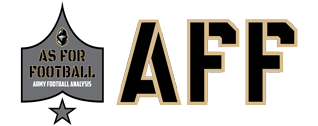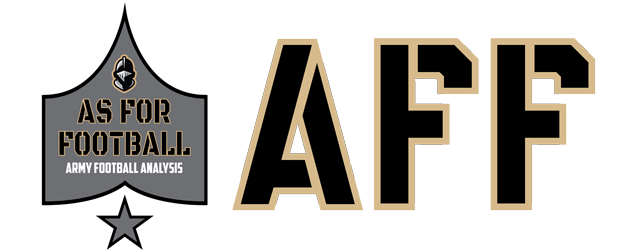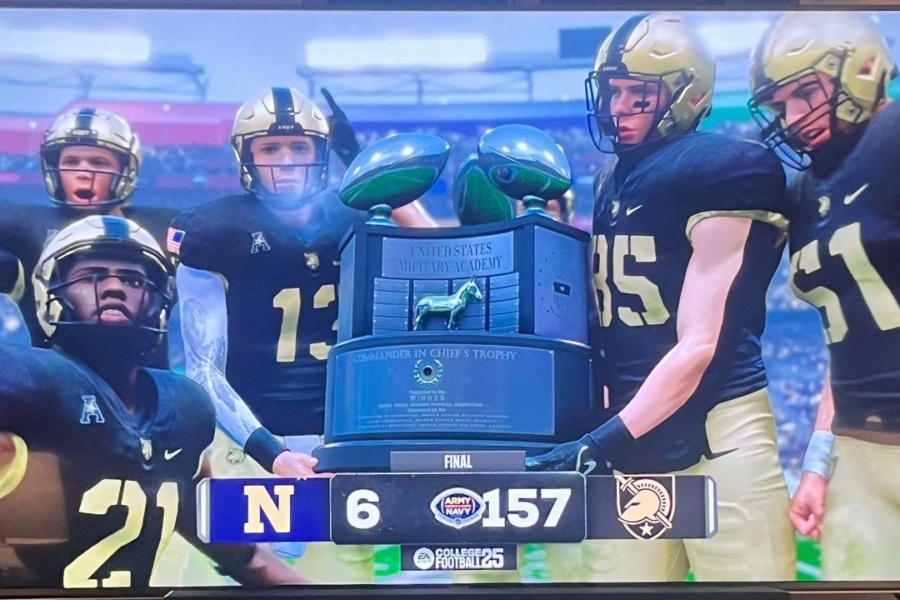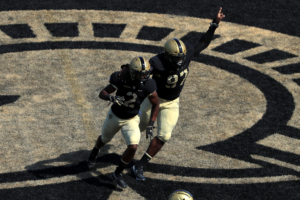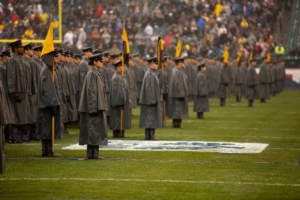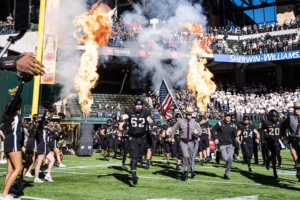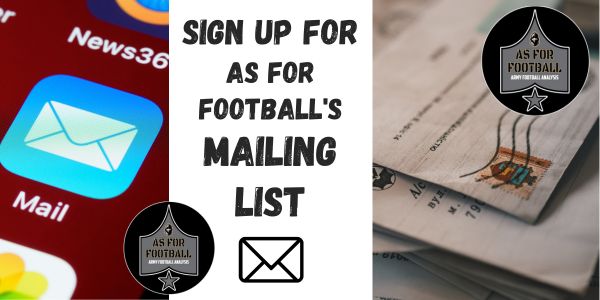It’s finally here! EA Sports has finally dropped their new, long-awaited college football game, NCAA College Football 25. We didn’t know what to expect from this game. After such a long wait, what could EA Sports do to impress us? Would the game be better than Madden?
Thankfully it is.
In fact, this game marks a massive improvement over the old one. For one thing, running the ball has become legitimately viable for in-game offenses. Moreover, given that most college quarterbacks struggle with throwing accuracy over time, you actually have to run the football.
As Army fans, this is how we like it.
RUN. THE. DAMN. BALL.
We’ve noticed, though, that folks who understand football have had success with this game whereas gamers who don’t typically get into the details about things like How to Make Reads in the Option have tended to get frustrated. We also know that lots of folks want to play as Army, but oh by the way, Army’s playbook is WAY more complicated than just, “Hey, let’s run the ball on every down.”
So yeah. This is one of those times when the reality that “No one played Navy as a kid” has run into, “Oh crap! Football at Army is hard!” With that in mind, this week’s article seeks to help you play better as Army in the game.
If you’re new to Army Football, we humbly suggest that you start with our Army Football 101 article, “The Triple Option”. You may also want to read about “The New NEW Offense” to see how last year’s real-world experiment with the Shotgun Option might affect this year’s playcalling and on-field execution, both in reality and in the game.
Overview
With Name, Image and Likeness (NIL) taking over college football, the rosters in the game have gotten as good as they can get. EA did a fantastic job making the players look as close to their actual selves as possible without using motion capture for every player on the 135 rosters of the Football Bowl Subdivision (FBS).
Overall, the graphics look tremendous. EA upgraded the game to 4K for the next gen consoles where NCAA 14 peaked at 1080p. The Stadiums also look great, though we might’ve preferred to see The Corps of Cadets in Dress Gray — at least for Army-Navy.
What can you do?
Commentary offers a wide range of voices from Jesse Palmer to Reese Davis. There are even different potential commentators for each game to provide a feel for the significance of the game based on the broadcast team. That by itself is incredible.
Run The Damn Ball
Bottom line, if you like to run the ball, you will like this game. There are a lot of great running schemes. Happily, the service academies are each modeled differently, and especially with Army, you can rack up a lot of rushing yards in a short amount of time if you know what you’re doing.
First Tip: When playing as a service academy, do not allow yourself to get fixated on a handful of plays that you know how to run. Finding success with the triple-option is about keeping your opponent off-balance. You won’t get there using a tiny fraction of the playbook.
Only played an hour last night and will do more this week, but I found it was easier to read the LB/CB on the outside pitches than it was to read the gaps for the dive and midline. However, I was able to spring some real nice inside trap runs with Robinson and Udoh. Their juke moves are great. They did Daily a disservice with his break tackle/truck stick skills, it should be higher
–Mike Davis, via the Firstie Club
Designed Runs
Everybody who plays the option wants to run a pitch play for a big gain. However, if you’re new to Army Football, we think you might want to start with some designed runs. Army’s playbook offers plenty, and in fact, the team uses them in real life for the same reasons that new gamers might want to start with them.
They simplify reads in the offense.
The Fullback Dive is Army’s staple offensive play. From there, look to add in Quarterback Zone runs, the Quarterback Follow, Fullback and Quarterback Counters, the Rocket Sweep, and the Reverse. With these plays, you’ll be able to attack the defense running inside and outside, both to the field and to the boundary. Add in an occasional downfield passing play, and you’ve got most of an effective service academy offense.
In reality, Army has become much less of an option team over the years and much more of a straight-up power running team. These designed runs have therefore become increasingly important to the team’s success — and to yours when you’re playing as the Black Knights.
Note that mismatches at the line strongly impact your ability to run the ball. For example, if you have a mismatch with the defensive tackle over your offensive tackle, it will impact your ability to run the ball on the edge. These mismatches at the line are one of the newest nuances of the new edition of the game. You will have to get into the overlays on the controller to actually see if you have a mismatch or not, and you’ll need to learn to manage these mismatches against your playbook.
2024 🔜 🏈 pic.twitter.com/bOjnuWBQfa
— Army Football (@ArmyWP_Football) July 20, 2024
Speed and Power Options
Those are double-options that do not involve the fullback, typically run outside the tackle box. The defensive end (DE) becomes the first key for the double-option. If the DE attacks the quarterback, pitch to the slot back. If the end or a defensive back — usually a safety — attacks the pitch man, the quarterback keeps, making this a Quarterback Run.
We’ve seen a lot of players looking to pitch the ball every time they run the option. In both reality and in the game, though, defenses realize that undefended pitch men get big gains. You should therefore do yourself a favor and look for the Quarterback Keeper if it’s there. Using the Keeper also reduces the possibility of a muffed pitch, a very real concern in true on-the-field play.
Played for a few hours last night. Gameplay is awesome, the vibe and realism of Michie is awesome too. I did Dynasty. Army starts off as a low rated team, and the fans in Michie stadium are sparce. The game has dynamic seating, so when I start winning, they will fill up more. I’ve heard a full Rocket from the cadets (no arm motions), and I’ve heard the commentators compare Robinson to Glenn Davis.
–Erik Robert, via the Firstie Club
The triple option is backwards from the old game. you need to hold A for the QB keep (opposite in NCAA14). I agree its easier to read the LB/CB on the outside, and it seems that Robinson has some pretty great speed. QB Power is my go to though, I can consistently get 3-4 yards with Byson up the middle. FB Dives and Whams are typically effective, but are more easily adjusted to.
I’ve also found that the defensive line for the opposing team gets crushed though the game in regards to wear and tear (ive seen as much as -18 on their stats) if I just pound the rock all game. I typically have to take Bryson out in the 4th QTR if I’m up by a bunch due to wear and tear, but suprisingly my RB/FB/OL are all usually healthy throughout.
Triple Options
Start by noting the position of the defensive tackle (DT). If the DT is over the guard or in the gap, you want to pull the ball and let your quarterback keep it. If there is a guard-tackle gap, though, run the Fullback Dive. This rule applies for both the Midline Option and the Veer; it just depends on which variation of the triple you’re running.
Your key will shift depending on where the Dive goes. If the play goes between the center and the guard (the A Gap), then key the DT. However, if it’s between the guard and the tackle (the B Gap), you’ll need to key the DE. Note that getting the Fullback Dive right takes some reps, and feedback overall tells us that it can be more challenging to make inside reads than reads outside on the Option Pitch. As with much in this game, the simulation mirrors real life.
If your quarterback pulls the ball after the snap, the DE’s actions become your second read. As with the double-option, if the DE crashes the quarterback, pitch to the slot back. If the DE attacks the slot, then keep running. However, the pitch is preferred if the end is coming towards the QB.
Pitch the ball before you make contact with any defenders. Otherwise you might not get the ball out successfully later in the game once wear-and-tear starts setting in. Also be sure to recruit speed for your slot backs to take your pitch game to the next level.
Gameplay and Coaching
The wear and tear system makes player management important. If you players take a hit, it affects them, and the game will show you what areas are affected as well as the impacts on player performance attributes. As the Head Coach, you have to make sure that you have your substitution set prior to kick-off to maintain fresh players. Wear and tear leads to interceptions, fumbles, and dropped passes.
Note that the new passing system takes some getting used to. You will probably throw a lot of interceptions early in this game, especially if your quarterback doesn’t have a cannon for an arm. As with so much else, this mirrors real life. Slower thrown balls give defensive backs opportunities to close the gap and make interceptions. You can always use the legacy system that is in the game, but that will come back to bite you when you play online.
Note, too, that service academy receivers don’t tend to get a lot of separation down the field. This should impact not only how often you throw but also which routes. You probably don’t want to just throw it up on a go route and hope for the best.
Coaching Challenges
The game’s layered control system provides a challenge. So many features exist on the controller that there you basically get a button for everything. This might be the most time-consuming aspect of the game overall.
Pre-snap adjustments matter on offense, but you have to make them before the play clock runs out. On defense, the adjustments don’t benefit you as much; they are more about misdirecting and confusing the opposing team’s quarterback. For example, you want to disguise your secondary coverages to increase your chances of success against the passing game. Note, however, that while you have the option to try to guess the play when you’re on defense, a wrong guess will cost you badly. If you guess run on a play action pass, you will end up in Cover Zero and might wind up giving up a touchdown.
Unfortunately, the game offers no mass substitution function. Even with the wear and tear system, you can’t put in your entire second-team offense or defense in to save your starters. If you get up by 40+ points, and you want to get some in-game experience for your underclassmen, you have to do it manually.
The game gives you multiple playbooks, but playbooks are locked to teams. However, a few generic playbooks exist that can give you more plays. We recommend the generic option playbook for Army because it offers more shotgun option plays and therefore more flexibility. Otherwise, thumb through all the teams and find out which one works best for you.
Get Started Right
It seems like most people just dove straight into Play Now or Dynasty mode without using the Practice mode to make sure that their skills from NCAA14 and/or Madden carried over into the new game. However, some key differences exist. Our best suggestion to get to learn the game before starting your first Dynasty is to play through the Ultimate Team.
Ultimate Team has skill building mini-games that help with all aspects of the overall game itself. One example is Rush for 30+ yards in the game. Ultimate Team drops you into game-like scenarios and allows you to earn points and card packs —like old-school collectables — to build a fantasy team. You can then develop a winning roster that you can play against the computer or online at all three levels of the game overall — Freshman, Varsity and All-American — and if you don’t play well, it does not impact your Dynasty or your coach’s development.
I wish I would have known all of that before I started my first season.
Mine just arrived today – perfect timing. I probably would not have even tried UT without this article!
–Joey Odell, via the Firstie Club
Final Thoughts
So far so good with College Football 25. Are there tweaks that I would like to see made?
Yes, obviously.
But overall, the game succeeds where it needs to succeed. It straddles the fence, providing detail for hardcore football fans while being accessible enough to those who just want to play a video game about college football. At one point, the game had more than 600K players on the sticks during launch week. With that kind of success, EA will continue to make improvements to keep the player base happy.
Many of the hardcore College Football Revamped players have some deep thoughts on this game, but not all of that stuff can be considered accurate criticism of the new game. However, I am not going to complain about the guys who updated graphics and rosters for NCAA 14 for over a decade. I’m just gonna tune that out and focus on building my dynasty.
This game is as good as it gets, at least until Labor Day.
Until next time #BEATNAVY!
